Integrate Your Devices and Streamline Their Control With These Expert-Recommended Smart Home Hubs
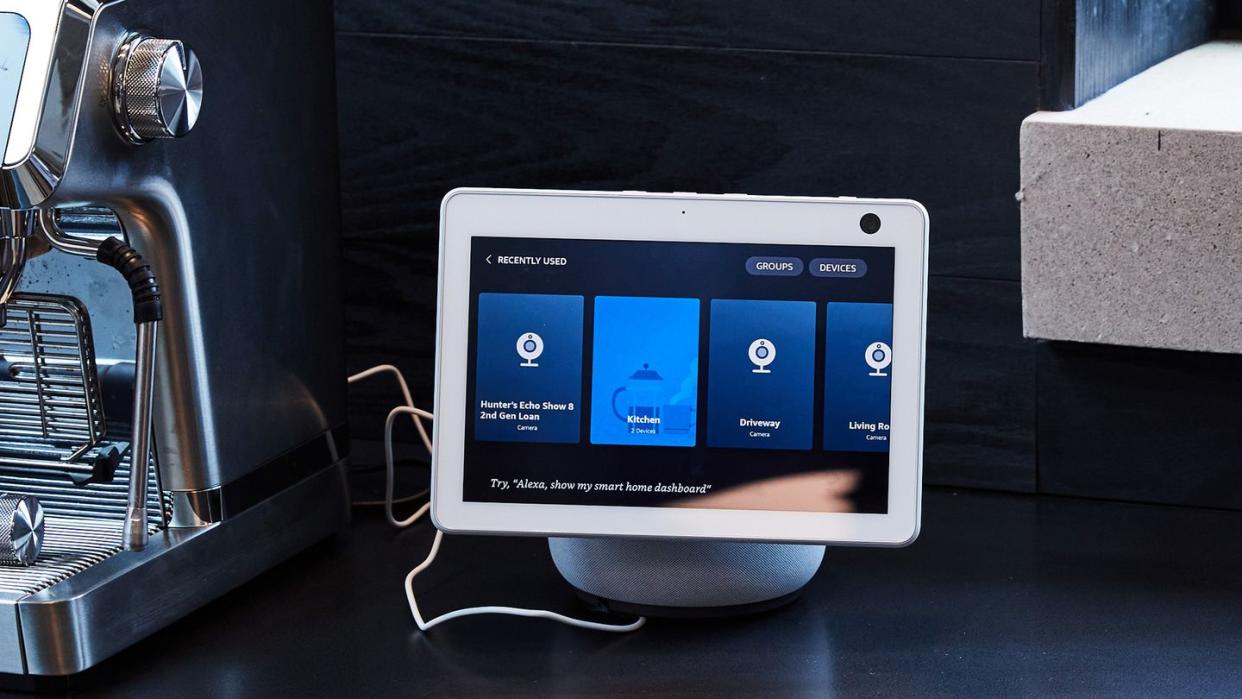
"Hearst Magazines and Yahoo may earn commission or revenue on some items through these links."
There are dozens of smart devices—light bulbs, locks, displays, doorbells, security systems, indoor/outdoor cameras, thermostats, appliances, plugs, blinds and shades—that are all vying for a place in your 21st century home.
According to the Consumer Technology Association (CTA), more than half of the households in the United States own a smart speaker with or without a display. Nearly a third own a smart doorbell camera, and more than one-in-five own smart lighting.
If you think finding, buying, setting up, and using these smart home gadgets seems daunting, you’re not alone. What can be confounding is that each tech giant—Amazon, Google, Apple, and Samsung primarily—pushes its own particular smart home platform.
But setting up one or more smart devices to perform specific functions or solve specific problems might well be worth the investment. You may already own more smart devices than you think, such as a smartphone and a smart TV, both likely controllable by voice. In other words, you already own the basic building blocks of a smarter home.
Best Smart Home Systems
Best Overall Smart Home Hub: Amazon Alexa Echo Show 8
Best Smart Home Hub for iPhone Owners: Apple HomePod Mini
Best Smart Home Hub for Android Owners: Google 7-Inch Nest Hub
Best Smart Home Hub for Smart Appliances: Samsung SmartThings Station Hub (without Power Adapter)
Best Smart Home Hub for Lighting: Philips Hue White Smart LED Starter Kit
Best Budget Smart Home Hub: Roku Indoor Camera SE
The Expert
I've been writing about, reporting on, and reviewing consumer technology for nearly 40 years, and have been writing about, reviewing, and recommending smart home devices since they came into existence. Home automation actually dates back more than a century. Most observers place the birth of the “smart home” as we understand it to the introduction of the X10 protocol in the mid-1970s, so I was likely playing with smart devices since I got into the business in the early 1980s. Bluetooth and Wi-Fi, however, didn’t come into being until the mid-1990s, and both are the basis for all modern smart home tech. Then, of course, you can’t really have the modern smart home until the smartphone's arrival in the 2000s.
What To Consider in a Smart Home Hub
Connectivity
All smart home devices need to be integrated into your home Wi-Fi network, and most also require Bluetooth. For devices to work effectively throughout your home, especially doorbell and security cameras, be sure your Wi-Fi network supplies enough bandwidth to support multiple simultaneous video streaming with wide enough coverage. I suggest a minimum of 100Mbps.
Most modern Wi-Fi operates in the 5GHz radio frequency band, which is faster but less spatially efficient, while 2.4GHz is more robust to better handle video over a wider area, but slower. If you’re not sure, check if your router touts itself as “dual- ” or “tri-band” which implies compatibility with both 2.4GHz and 5GHz Wi-Fi frequency bands.
More to Consider: Best Smart Scales • Best Smart Kitchen Appliances • Best Smart Home Devices
Ecosystems
Major smart home ecosystems such as Amazon Alexa, Google Home, and Apple HomeKit are often referred to as “walled gardens.” Each ecosystem creates its own digital language so only devices within that garden understand each other.
Ecosystems do make controlling all of your various devices more convenient through a single app or one voice command structure. Housing all your smart devices under a single ecosystem also lets you create “scenes” or “routines” or “automations,” a series of multiple near simultaneous actions from multiple devices based on a single voice command, time of day, or other triggering action.
For instance, at midnight every weeknight, or by saying “Alexa, goodnight!” interior smart lights automatically turn off, smart window shades or blinds drop, smart locks bolt, smart thermostat lowers the temperature, the smart security system is armed, and outdoor lights turn on.
Protocols
Aside from the major smart home ecosystems, there are a variety of underlying wireless smart home protocols such as Zigbee, Z-Wave, and Thread that help smart home devices work together. Think of these protocols as speaking certain basic words or terms all devices need to understand, such as “on-off.” By and large, however, you can ignore these protocols if you stick within a major ecosystem or only plan to use individual smart devices with their own apps.
Voice Command
One of a smart home’s great positives and annoying failings is voice control. There is no doubt that speaking a command and having an inanimate device react is very Star Trek cool and much easier than pulling out your smartphone, finding the specific smart home app, and tapping the appropriate control icon to perform as simple a function as turning a light on or off.
But you’ll need to memorize precise phrasing to get devices to work via voice. If you incorrectly say “shut the window shade” instead of “lower the bedroom window shade,” there’s a good chance nothing will happen. Plus, voices from your TV or other inadvertent command may trigger sound-alikes that often mistakenly wake up your smart device.
How We Selected Smart Home Hubs
I chose these smart home ecosystems primarily based on their reach—their adoption by consumers and by smart home device makers—and the number of compatible devices available.
I did not necessarily consider “ease of use,” reliability, or even price, since all smart home ecosystems and devices present set-up and usage challenges that will vary from person to person and from household to household. These ecosystems encompass a variety of device price ranges as well.
Additionally, I scanned lots of reviews. Above all, I have interacted with/interviewed all the ecosystem vendors over the years, as well as for this article, and own and have been playing with smart home products from all noted ecosystem vendors. I have an Apple HomePod and HomeKit smart blinds, several Hue lights tied to several of the voice systems, a Roku security camera, several third-party Google smart speakers and Google Hub display, several third-party Alexa speakers and a Dot, and a Samsung Station Hub.
Alexa Echo Show 8
Amazon’s latest smart display, the Echo Show 8, is a smart speaker with an 8-inch display for answering questions, aiding with your Amazon ordering, providing for hands-free phone calls, streaming music, keeping your schedule, and playing content from myriad streaming TV services.
Primarily, however, the Echo 8 is a general Alexa “hub” that substitutes for your smartphone to add devices to your Alexa smart home system, provide voice commands for your Alexa-compatible smart devices, and includes a built-in security camera with a privacy shutter.
Alexa is the most widely adopted smart home and voice control ecosystem and offers more than 100,000 “skills” or command capabilities. To get easy voice control for your devices in rooms other than the one in which the Echo 8 is located, you can buy a wide variety of Alexa-enabled smart speakers both by and from Amazon and from other popular speaker brands such as Sonos, JBL, and Bose.
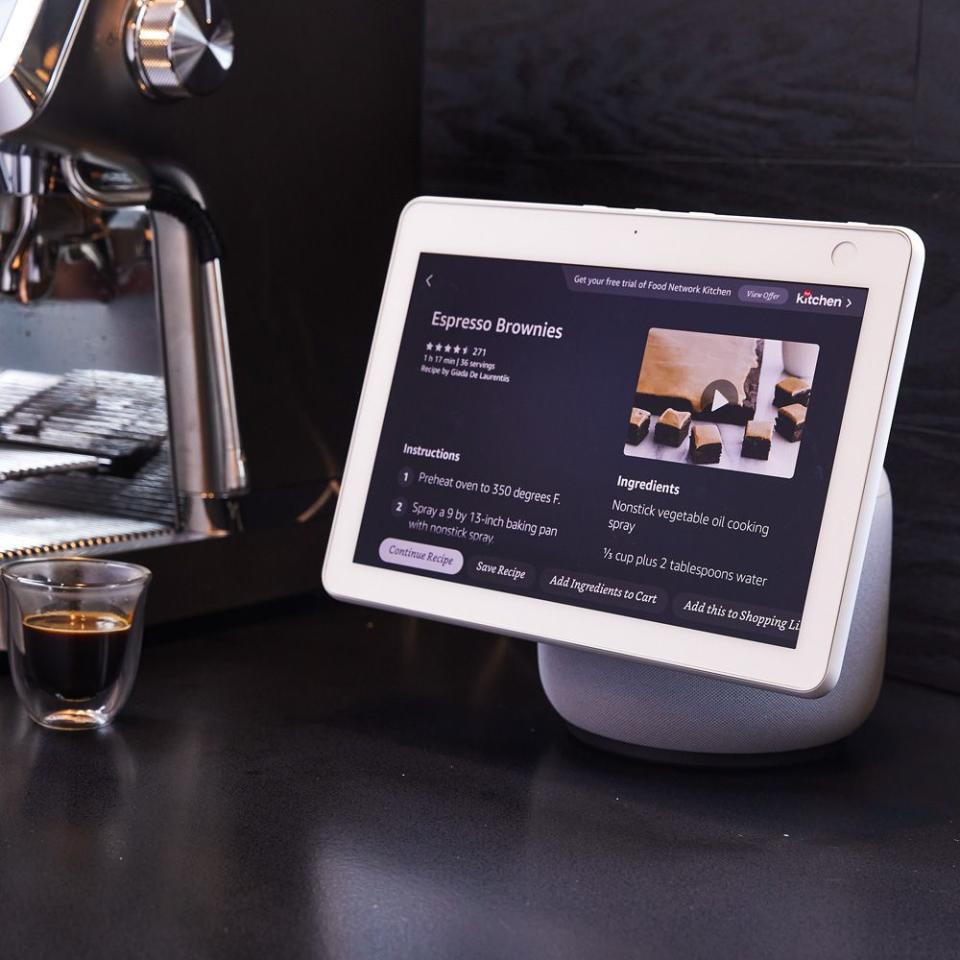
Alexa Echo Show 8
amazon.com
$149.99
Trevor RaabHomePod Mini
More than half of all Americans own an iPhone, which means most folks have ready access to a well-oiled, well-integrated smart home ecosystem. While Apple’s HomeKit ecosystem is not as widely supported as Amazon Alexa or Google Home, it covers the basics.
Since HomeKit is Apple, you can be assured of three things: whole-home Siri voice control access through Apple’s many Siri-enabled Apple devices; it is easier to add and group HomeKit devices and actions than other ecosystems; and, your smart home is highly secure since Apple is famously a stickler for vetting and securing its app, devices, and connectivity.
As a speaker, the HomePod mini delivers 360-degree sound, it can be paired with a second HomePod mini to create stereo sound, or grouped with multiple HomePod minis to create a whole home sound system. To blend easily with your room décor, HomePod mini is available in five colors.
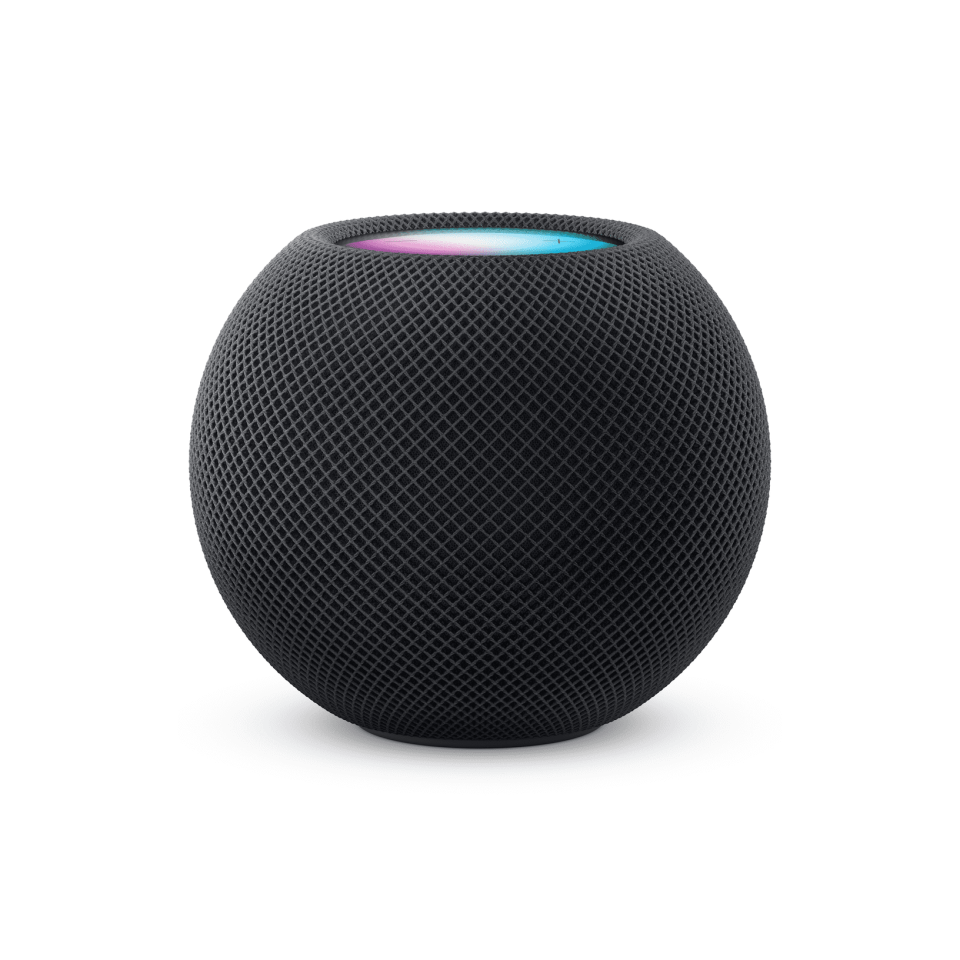
HomePod Mini
walmart.com
$99.99
7-Inch Nest Hub
Google Home is the second most popular smart home ecosystem behind Amazon Alexa, offers a staggering million-plus “skills,” and has been rated as having the smartest voice assistant.
The Hub is an easy Google Home starting point to easily add a wide variety of direct-compatible Nest devices and “works with Google” gear from other manufacturers, including a plethora of Google-compatible smart speaker makers. Bonus: It’s compact enough to fit on a night table and operate as an alarm clock.
Best of all, unlike the need for a smart speaker in each room to access your Amazon Alexa smart home via voice, Google’s voice smart home control is natively available via all Android devices.
If you want to add more smart home capabilities, such as a built-in Google Nest Cam security camera, better and more powerful speakers, and video calling, you can step up to the 10-inch Google Nest Hub Max.
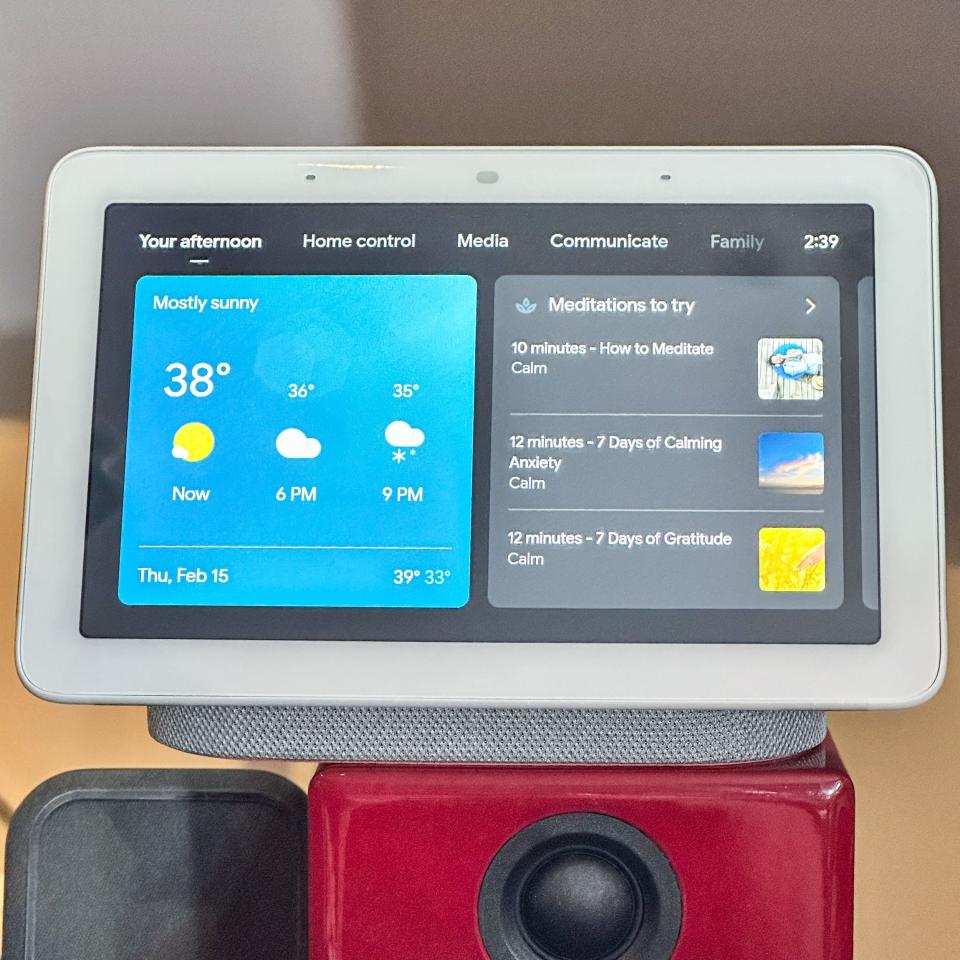
7-Inch Nest Hub
amazon.com
$69.95
Stewart WolpinSmartThings Station Hub (without Power Adapter)
While Google Home is well integrated with Android, and Apple HomeKit with Apple’s devices, SmartThings is similarly well integrated with all Samsung smart products—smartphones, earbuds, smart TVs, smart devices, Philips Hue smart lighting, and especially Samsung’s wide variety of smart appliances, including the company’s smart Family Hub refrigerator.
Many SmartThings-compatible Samsung devices can be used to integrate additional smart devices and create mixed automated “routines,” and SmartThings Energy uniquely helps you monitor power consumption of your smart Samsung appliances.
SmartThings considers itself an “open” platform and, therefore, can integrate devices from the other three major home ecosystems. The SmartThings Station Hub includes a single physical button to activate several “scenes,” and it is a wireless smartphone charger pad as well.
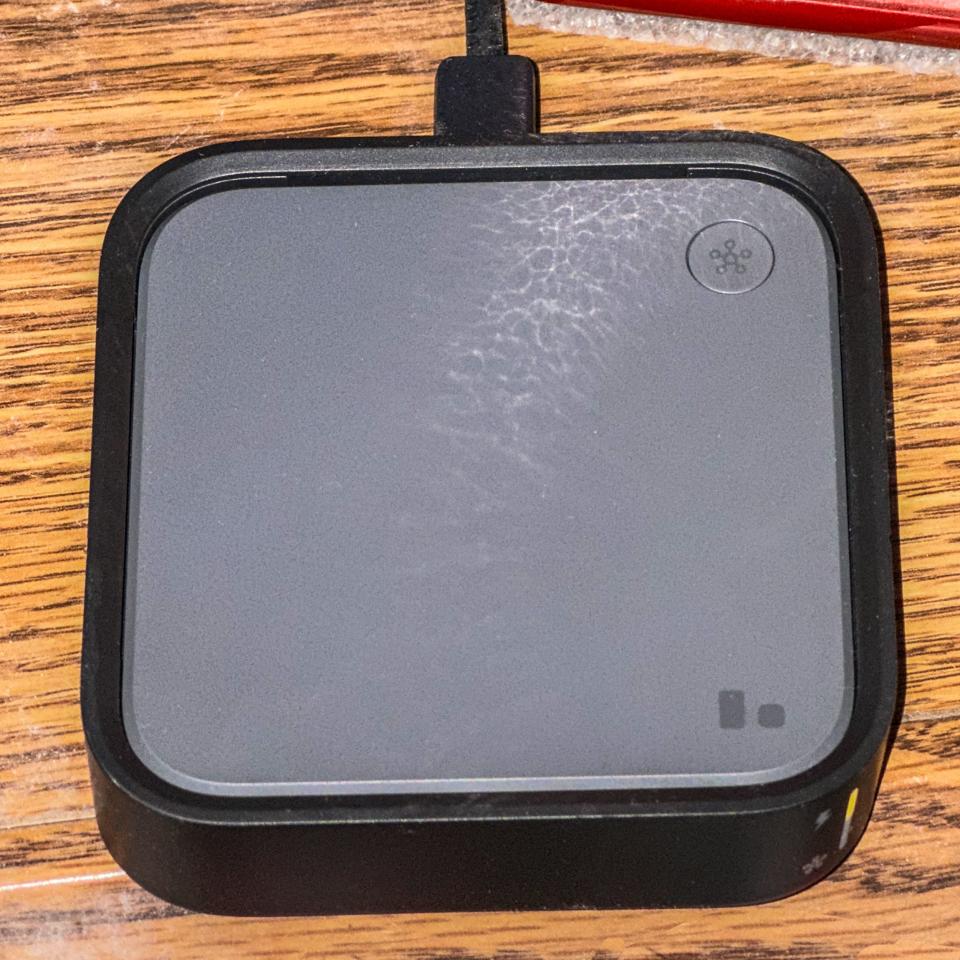
SmartThings Station Hub (without Power Adapter)
walmart.com
$59.84
Stewart WolpinHue White Smart LED Starter Kit
Philips Hue is an excellent smart home entry point. There are several Philips Hue starter kits that include multiple smart multi-color LED bulbs, a Hue bridge (which connects the system directly to your Wi-Fi router and enables your Hue lights to be integrated into any of the major smart home ecosystems), and a few with a wall wireless dimmer switch. But this basic kit includes a Hue bridge and two white 75-watt-equavilent dimmable smart LED bulbs.
You can expand your Hue system with a panoply of Hue smart table, wall, and ceiling lighting fixtures. Hue also has solved the smart light on-off power dilemma with its Wall Switch Module that turns off a Hue bulb at the light switch but still keeps the power to the bulb flowing for voice or app control. Plus, a Hue motion sensor can trigger lights to automatically go on or off when you enter or leave a room.
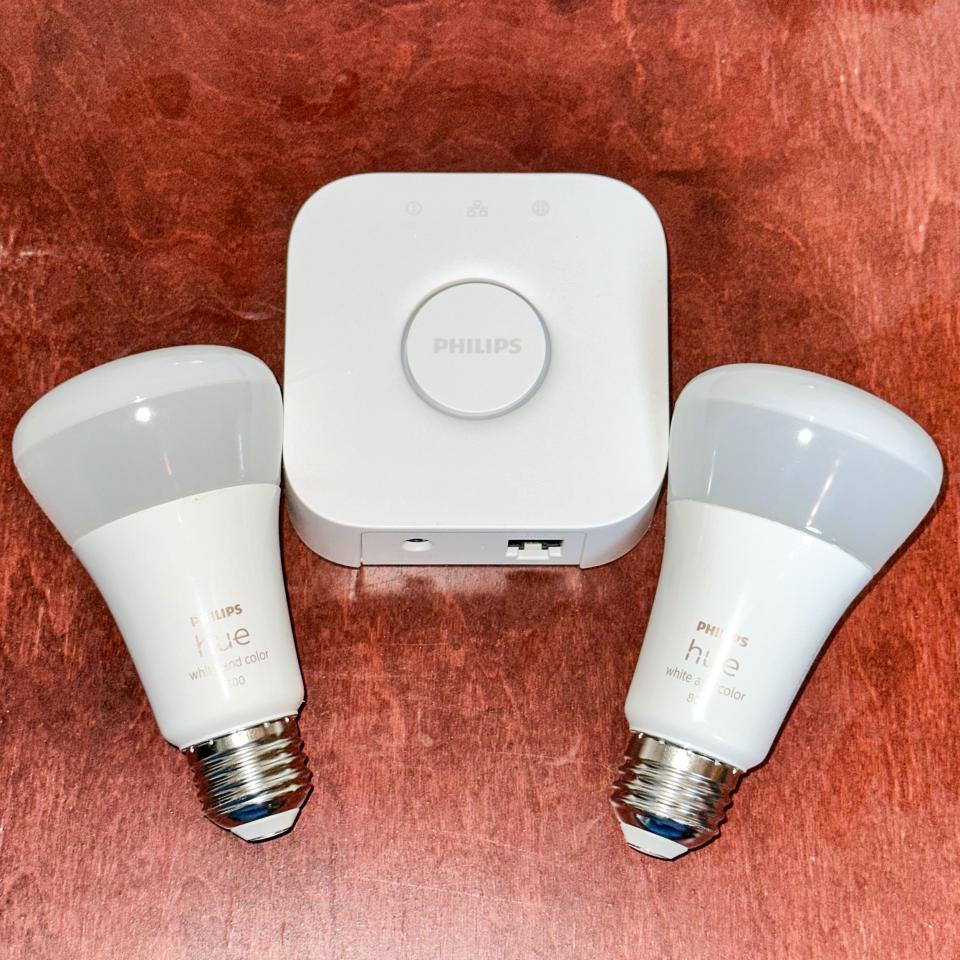
Hue White Smart LED Starter Kit
walmart.com
$69.99
Stewart WolpinIndoor Camera SE
Roku has expanded beyond its streaming TV set-top box and smart TV service into smart home, and the company offers an ever-expanding variety of low-priced smart home products—all priced less than $100—that can be accessed and controlled by the company’s smart TV interface.
For instance, you can view live or recorded smart camera footage on a Roku smart TV, and devices can be voice commanded via the Roku smart TV remote control.
Accessing all this Roku security camera’s features, such as continual cloud recording for up to 14 days and person/pet/package/vehicle detection, requires a subscription ($3.99/month, $39.99/year).
Sans subscription, you get 1080p full color high-definition video (even at night), adjustable motion detection sensitivity and zones, two-way audio, smoke and CO detection and alarm, and you can install a 32GB microSD memory card to locally record footage.
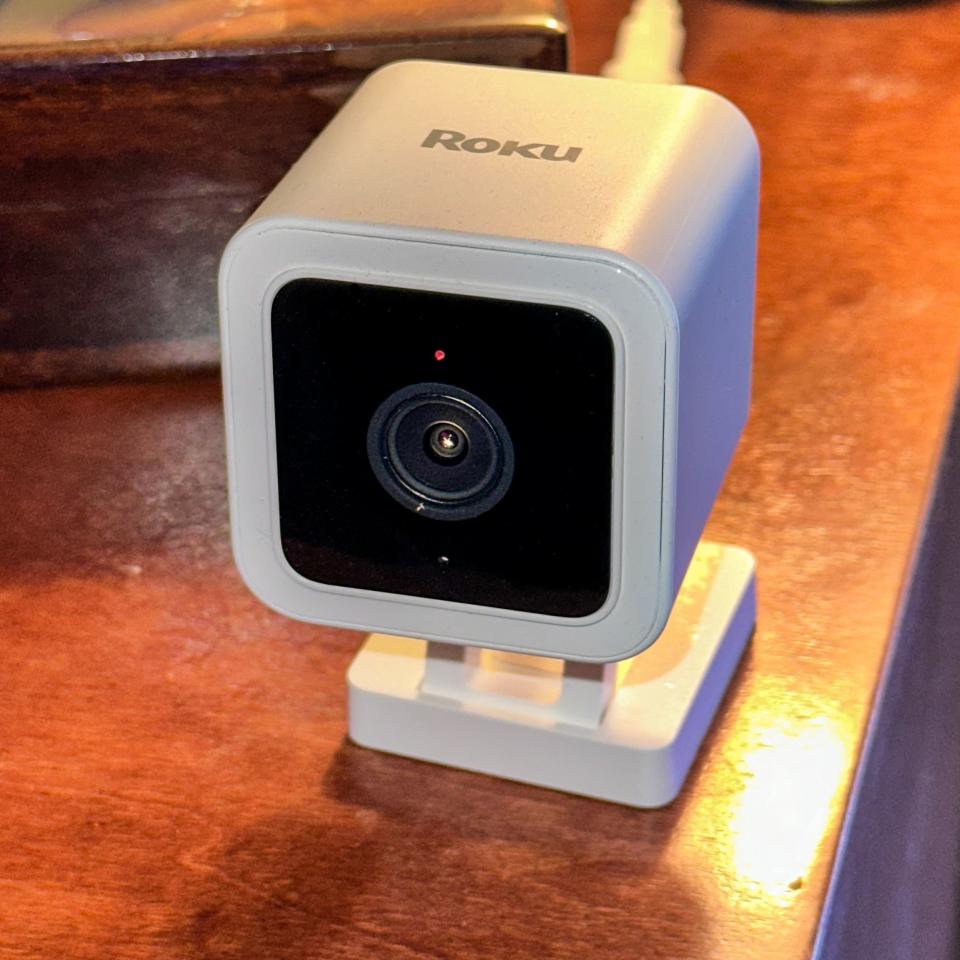
Indoor Camera SE
walmart.com
$26.88
Stewart WolpinExpert Stewart Wolpin’s Guidance on Your Smart Home Transformation
What’s the best way to choose a smart home ecosystem?
Check to see what smart home devices you may already own and which ecosystems they are already compatible with. Try pairing one of your smart devices with a different but compatible ecosystem, and if possible, create a “scene” or “routine” to understand the process, compare how each ecosystem works, and to compare voice control efficiency.
Also consider which smartphone you own. If you own an iPhone, you’re better off with either Apple’s own HomeKit or Amazon Alexa; if you use an Android phone, your smart home system will likely operate easier and more efficiently with Alexa, Google Home, or SmartThings.
If you own a Samsung TV, start with SmartThings; if you own a Roku-enabled smart TV or use a Roku TV attachment, start with Roku’s smart home system. In all events, the key question you need to answer is this: is the “smart” solution easier and more efficient than the old-fashioned method?
What is the difference between a smart speaker, a smart home hub, and a smart home bridge?
A smart speaker or a smart display is merely one device in your smart home system and can work independently of or in concert with other smart devices on the same ecosystem, such as an Amazon Echo smart display on the Alexa system.
A smart speaker or smart display such as the Google Nest Hub also acts as another control center for your smart home system, supplementing your smartphone.
A “hub” or a “bridge”—terms often mis-applied or used interchangeably by smart home device makers—is a set-top box that usually needs to be physically connected via an Ethernet cable your home Wi-Fi router to enable smart devices to interface and operate with other smart devices from different ecosystems or using different smart home wireless protocols.
There are a variety of third-party multi-protocol smart home hubs or bridges such as Homey, HOOBS, IFTTT, Aeotec, and Homebridge, that create their own app-controlled ecosystems and allow you to mix, match, and control otherwise incompatible smart home devices.
How easy is it to mix and match or combine controls of different smart home devices in a single app?
It’s not easy. Nearly every smart home device extant is designed primarily to pair with its own individual smartphone app. While most smart home device makers offer ways to pair a device to a larger voice-controllable ecosystem, the actual linking app-web page mechanics are often frustratingly tangled.
Then, after spending time and effort going through the linking rigmarole, you may succeed—or you may not for reasons you’ll never discern. Even if you’re successful in linking your singular smart home device to a larger ecosystem, you may not get all the features and controls.
To solve the smart home device walled garden/incompatibility problem, nearly 300 smart home companies got together and last year launched an interoperable smart home standard called Matter, overseen by the Connecting Standards Alliance (CSA), that lets smart devices from varying ecosystems understand each other and work together.
But Matter isn’t yet universal; for instance, in its current form, Matter doesn’t let you add security or video doorbell cameras. Bottom line: even with Matter, at least in its current state, you’re still better off sticking within one of the major smart home ecosystems if you want to synchronize your varying smart devices.

You Might Also Like

